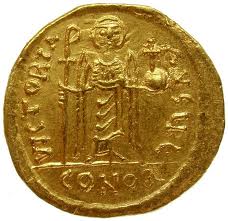|
Byzantine coins are one of the most challenging and complex series to collect. Bronze issues, most of which are folles or 40 nummia pieces and divisions of that denomination, are frequently crudely struck, often over previous issues. By far the most extensive part of this thousand-year coinage series are gold solidi and their successors.
While the beauty and richness of the ancient Greek and early Roman coinage remain unsurpassed, the Byzantine series, with both the stability and variety exhibited during its thousand-year span, remains unique in the history of numismatics. Throughout this period, Byzantine coins came in three basic metal types: gold, silver and bronze.

The transition point between the (Eastern) Roman and Byzantine empires - typically placed somewhere between the 4th and 7th centuries - is largely a matter of historical convenience, since the Empire itself knew no such distinction. The usual numismatic convention is to begin the Byzantine period of coinage with the great monetary reform of Anastasius I, in 498 AD.
There are relatively few silver issues because the Empire did not have a reliable source of silver production. During the Late Empire the gold coinage was debased by adding silver, and after more than a thousand years since the end of the Greek electrum coinage, that alloy reappeared as a significant numismatic metal.

The gold solidus, inherited from Constantine, saw a long time in circulation. Emperor Nichephoros II Phocas (963-968), because of financial problems, introduced a new gold coin, named tetrateron, or quarter, smaller and thicker, in contrast with the full weight coin, named histamenon , who remained large and thinner. Michael IV (1034-1041) made for the first time a reduction of the title, the first since Constantine the Great (308-337).
Beginning in the earlier reign of Michael IV (1034- 1041) the purity of Byzantine gold coins was gradually adulterated, falling to 26% by the accession of Alexius I in 1081, possibly reflecting the declining fortunes of the Empire following the death of Basil II - though an alternative view sees a need to get more coinage in circulation, due to an expanding economy.
Some of the most beautiful bronze coins of the Byzantine times are the so called anonymous follies of the X-XI century, with the portrait of Jesus Christ on obverse and a large variety of reverses. Throughout the entire millennium-long run of the empire, there are many different denominations issued by a wide network of mints. Some pieces are as intricate and interesting as even the Greek coins, what many numismatists consider the high point of ancient art on money.
|

![]()

